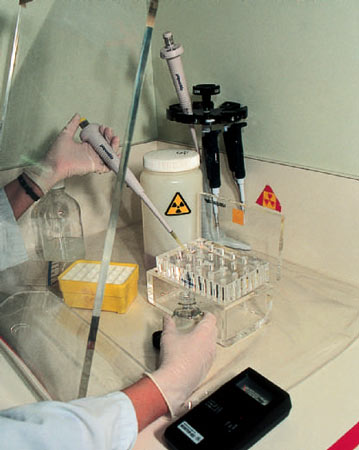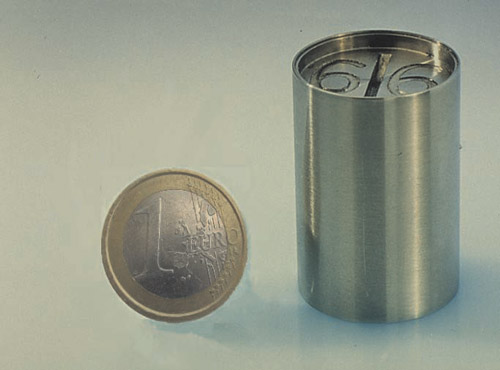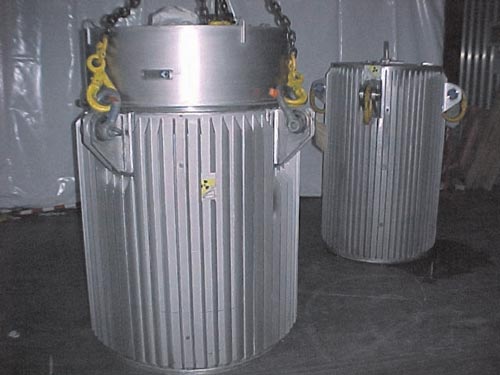Radioactive sources, producers of waste outside the nuclear industry…

Laboratory handling of radioactive substances
Nuclear medicine institutions and biomedical research laboratories mainly use unsealed sources, which are radioactive elements contained in liquid solutions. Most of these radioactive elements are very short-lived. Consequently, empty bottles used to hold radioactive liquids, together with small items of laboratory equipment (tubes, glassware, gloves, syringes and needles) lose their radioactivity quickly.
© ANDRA

Sealed source
Used sealed radioactive sources are considered as waste once the radioactive substances they contain are no longer able to perform their task owing to the decline of their activity. Sealed sources contain a very wide range of radionuclides, including the short-lived I192, Co60, Cs137, Sr90,and long-lived alpha emitters Ra226, Ac227, U235, U238, Pu238, Pu239, Pu242, Am24, Cm244 … Sealed sources containing alpha emitters are by far the most numerous.
© ANDRA
Biology laboratories and hospitals use a wide variety of radioactive products. The life of the radioelements used for nuclear medical examinations is ultra-short in waste management terms, which define half-lives of up to 30 years as ‘short’. For example, the half-life of fluorine-18, used for diagnosing cancer by means of positron emission tomography, is 118 minutes, and that of technetium-99m, used for scintigraphy, is 6 hours. These timescales are so short that express delivery has to be used to transport the fluorine from its place of production and the technetium is produced in the hospital.
of up to 30 years as ‘short’. For example, the half-life of fluorine-18, used for diagnosing cancer by means of positron emission tomography, is 118 minutes, and that of technetium-99m, used for scintigraphy, is 6 hours. These timescales are so short that express delivery has to be used to transport the fluorine from its place of production and the technetium is produced in the hospital.
Maintaining a supply of sufficiently fresh radiopharmaceuticals is more of a problem than disposing of the empty bottles. The empty bottles used to hold radioactive liquids and small items of laboratory equipment (tubes, glassware, gloves, syringes, needles, soiled cotton wool) are very short-lived waste. They are put aside for a while, then disposed of with the rest of the hospital waste following a final check of their residual radioactivity.
The situation with treatments is slightly different. The radioactive sources are more powerful and they are not ultra-short-lived. This is the case with caesium-137 (half-life of 30 years) and especially cobalt-60 (half-life of 5 years). The sealed sources are sent back to the suppliers after use. At the production units, the solid waste is placed in special containers to prevent any radioactive, chemical or infection risk. There is a very small amount of waste that cannot be managed in this way and has to be sent to an Andra disposal facility.
Iodine-131, which is used to treat some thyroid cancers, is also dealt with separately. Aqueous effluents from laboratories and from the bathrooms of hospital bedrooms reserved for patients who have received doses of iodine-131, are collected in tanks and stored to allow decay to take place on site. Iodine-131 has a half-life of 8 days. After a few months, the contents of the tanks are no longer radioactive.
In the research field, ANDRA counted 346 entities that use radionuclides and therefore produce waste. These establishments, which are both public and private, include medical research laboratories (many located on hospital premises), INSERM units, chemical and pharmaceutical industry research units, and CNRS laboratories.

Containers for storing sealed sources
A sealed radioactive source become a waste when, because of decay, it is no longer sufficiently radioactive to be used as originally intended. Sealed sources can contain a wide range of radionuclides: 192I, 60Co, 137Cs, 90Sr (short-lived); 226Ra, 227Ac, 235U, 238U, 238Pu, 239Pu, 242Pu, 241Am, 244Cm (long-lived alpha-emitters). The majority of spent sealed sources contain alpha emitters.
© ANDRA
In another field, the large facilities of the CNRS National Institute of Nuclear Physics and Particle Physics (IN2P3), particle accelerators such as GANIL in Caen, the SOLEIL synchrotron and those at CERN on the Franco-Swiss border, produce and store waste.
In cellular and molecular biology, radionuclides are used to mark the molecules into which they are incorporated. They are often used as small liquid specimens. After use, the sources and waste are generally handed over to Andra, which sends them for processing to the specialist company CENTRACO, or if the waste has a half-life of less than 100 days, they remain on site until their radioactivity has decayed. The use of unsealed sources also leads to the production of contaminated solid waste (gloves, tubes, glassware).
The majority of this waste is low- or intermediate-level short-lived waste (LILW-SL) or very low-level waste (VLLW). It is produced by research facilities such as particle accelerators, where equipment can become radioactive due to the flow of particles.
Other articles on the subject « Waste Inventory »
Recoverable materials
Inventory of reusable uranium and plutonium stocks The radioactive species present in the spent f[...]
France: waste panorama (1)
An overview of French waste categories… In France, radioactive waste is split into five cat[...]
France: waste panorama (2)
An overview of French waste categories (continued)… Low- and intermediate-level short-lived[...]
US panorama
The case of the greatest nuclear power Nuclear-powered US Navy vessels, past production of nuclea[...]
Various radioactive waste
Radioactive waste from many different sources… When radioactive waste is mentioned, people [...]
Mining residues
Waste from uranium extraction The residues from processing uranium ores are disposed of on the si[...]
Military waste
A separate system Using the gaseous diffusion process, the AREVA Pierrelatte facility produced en[...]
Radium-bearing waste
Legacy waste – weakly radioactive but long-lived Recent and less recent industrial activities hav[...]
Waste from Dismantling
Dismantling of facilities: graphite waste Experience with dismantling nuclear power plants is onl[...]
Waste from Industry
Obsolete radioactive sources, the legacy of radium applications There are numerous industrial app[...]